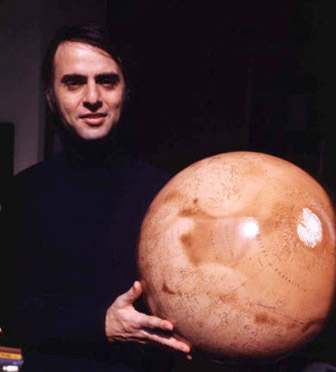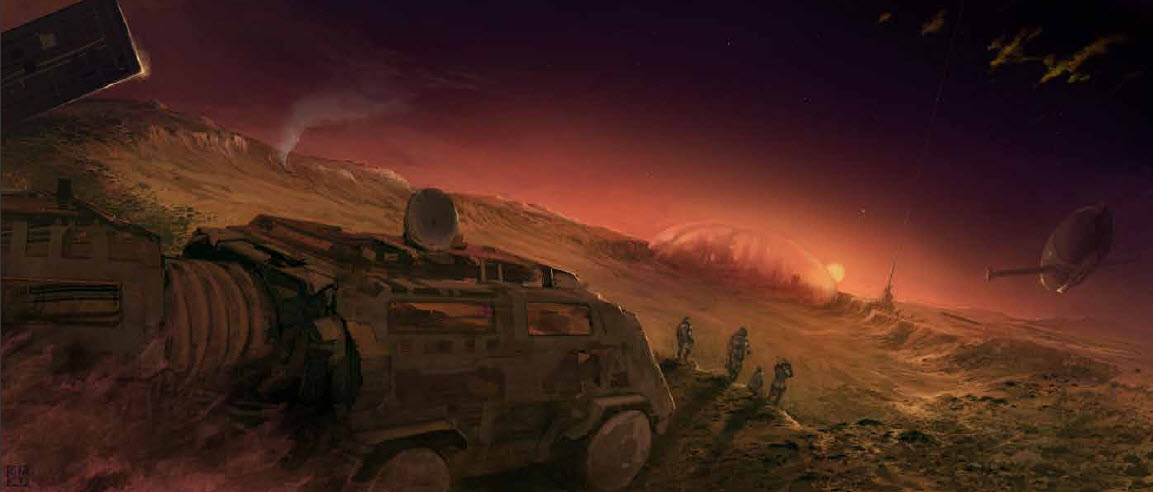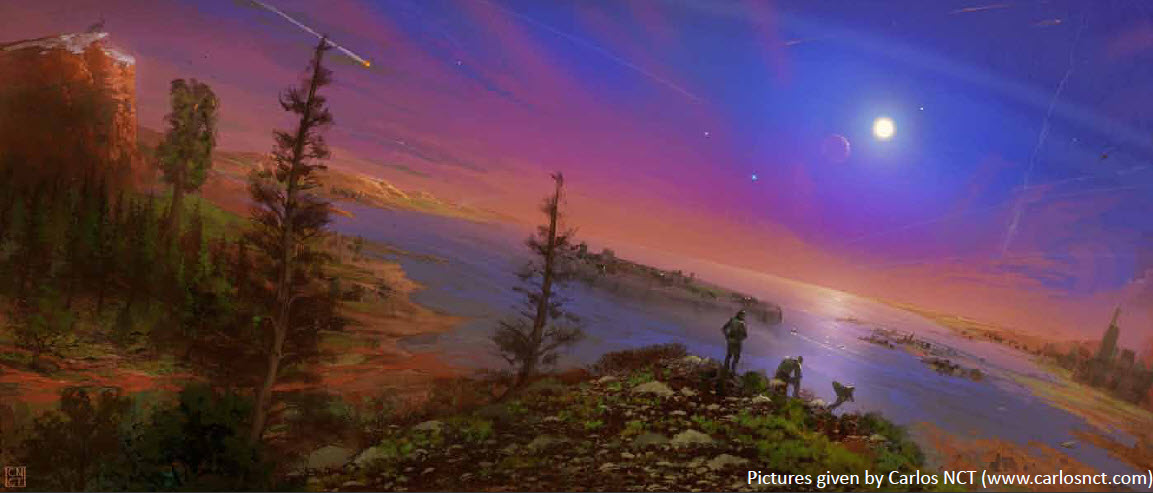Team:Valencia/Terraforming
From 2010.igem.org
(→Our project to terraforming) |
Alejovigno (Talk | contribs) (→An artistic view of terraforming) |
||
| (31 intermediate revisions not shown) | |||
| Line 10: | Line 10: | ||
[[Image:Valencia_robinson.jpg|thumb|center|600px|Kim Stanley Robinson with his ''Mars Trilogy'' has been one of the major inspirators of our work. They are really worth reading books.]] | [[Image:Valencia_robinson.jpg|thumb|center|600px|Kim Stanley Robinson with his ''Mars Trilogy'' has been one of the major inspirators of our work. They are really worth reading books.]] | ||
| - | In the scientific field, the first one who talk about terraforming of Mars was the ever-inspirational planetary astronomer Carl Sagan in ''The Long Winter Model of Martian Biology: A Speculation'' (1971) and in ''Planetary engineering on Mars'' (1973) both published in ''Icarus''. In [http://www.youtube.com/watch?v=XzVYwyxidDY ''Blues for the Red Planet''], the fifth episode of his mythical television series '' Cosmos: A personal Voyage'', he exposes his ideas to the public. Sagan’s plan for terraforming of Mars implies seeding its polar caps with dark plants. These plants will be artificially selected or genetically modified to resist and “survive” the harsh conditions of Mars climate. The positive point gained with this seeding will be realeasing oxygen and darkening the martian surface, melting down the polar caps and liberating the ancient martian atmosphere trapped in there. This fusion water could be transported to the equator by the construction of a network of channels, similarly to the one Percival Lowell believed an inexistent Martian civilization had constructed. Sagan’s opinion about the ethics of this terraforming process, in the case the planet result not sterile is categorical: | + | In the scientific field, the first one who talk about terraforming of Mars was the ever-inspirational planetary astronomer Carl Sagan in ''The Long Winter Model of Martian Biology: A Speculation'' ([[#References |1971]]) and in ''Planetary engineering on Mars'' ([[#References |1973]]) both published in ''Icarus''. In [http://www.youtube.com/watch?v=XzVYwyxidDY ''Blues for the Red Planet''], the fifth episode of his mythical television series '' Cosmos: A personal Voyage'' (1980), he exposes his ideas to the public. Sagan’s plan for terraforming of Mars implies seeding its polar caps with dark plants. These plants will be artificially selected or genetically modified to resist and “survive” the harsh conditions of Mars climate. The positive point gained with this seeding will be realeasing oxygen and darkening the martian surface, melting down the polar caps and liberating the ancient martian atmosphere trapped in there. This fusion water could be transported to the equator by the construction of a network of channels, similarly to the one Percival Lowell believed an inexistent Martian civilization had constructed. Sagan’s opinion about the ethics of this terraforming process, in the case the planet result not sterile is categorical: |
<blockquote> | <blockquote> | ||
'' "If there is life on Mars, then I believe we should do nothing to disturb that life. Mars, then, belongs to the Martians, even if they are microbes."'' | '' "If there is life on Mars, then I believe we should do nothing to disturb that life. Mars, then, belongs to the Martians, even if they are microbes."'' | ||
| Line 17: | Line 17: | ||
[[Image:Valencia_sagan.jpg|thumb|center|250px|Carl Sagan, the first scientist who study the terraforming of Mars, holds a model of the red planet in his hands (Hulton Archive/Getty Images).]] | [[Image:Valencia_sagan.jpg|thumb|center|250px|Carl Sagan, the first scientist who study the terraforming of Mars, holds a model of the red planet in his hands (Hulton Archive/Getty Images).]] | ||
| - | In the last years several review works about the concept of terraforming have appeared in the scientific literature. McKay and Marinova (2001) review the general aspects regarding the planetary ecosynthesis in the red planet and the ethics of that process. Graham (2004) has focused in the biological aspects of the creation of a biosphere on Mars and has delineated the stages of such a process. Finally Beech has written a book ''Terraforming: The Creation of Habitable Worlds'' (2009) in which the terraforming process is exhaustively analysed. To delve deeper into this exciting process, we recommend the reading of such works and the survey of the ethics of terraforming that we have written. | + | In the last years several review works about the concept of terraforming have appeared in the scientific literature. McKay and Marinova ([[#References |2001]]) review the general aspects regarding the planetary ecosynthesis in the red planet and the ethics of that process. Graham ([[#References |2004]]) has focused in the biological aspects of the creation of a biosphere on Mars and has delineated the stages of such a process. Finally Beech has written a book ''Terraforming: The Creation of Habitable Worlds'' ([[#References |2009]]) in which the terraforming process is exhaustively analysed. To delve deeper into this exciting process, we recommend the reading of such works and the survey of the ethics of terraforming that we have written. |
==Why Mars?== | ==Why Mars?== | ||
| - | In the actual conditions of Mars there is no organism able to survive and in no way grow. However, increasing evidences are revealing a different and biologically interesting ancient history (McKay, 2010). This early wetter and warmer martian conditions together with its closeness are the primary basis for carry out a planetary ecosynthesis on Mars. | + | In the actual conditions of Mars there is no organism able to survive and in no way grow. However, increasing evidences are revealing a different and biologically interesting ancient history ([[#References |McKay, 2010]]). This early wetter and warmer martian conditions together with its closeness are the primary basis for carry out a planetary ecosynthesis on Mars. |
[[Image:valencia_terra_table.jpg ||thumb|center|640px|'''Table 1'''. The physical parameters of Mars and Earth. Highlighted in red are the parameters that we have simulated in the MSC. Data from McKay and Marinova (2001)]] | [[Image:valencia_terra_table.jpg ||thumb|center|640px|'''Table 1'''. The physical parameters of Mars and Earth. Highlighted in red are the parameters that we have simulated in the MSC. Data from McKay and Marinova (2001)]] | ||
| - | Table 1 compares selected environmental and physical parameters between Mars and our cradle planet. Modifying the physical properties of Mars is impossible with the current technology, but some of these properties are very similar to those of Earth. For example the day length and the obliquity. The major differences as the year and season length, the lower surface sunlight and gravity may be no important obstacles in the creation of a biosphere (McKay and Marinova, 2001). Thus, Mars only will be terratransformed by changing its atmosphere. The idea is creating a new one thicker with a new composition that will lead the heating of the surface by means of a greenhouse effect. | + | Table 1 compares selected environmental and physical parameters between Mars and our cradle planet. Modifying the physical properties of Mars is impossible with the current technology, but some of these properties are very similar to those of Earth. For example the day length and the obliquity. The major differences as the year and season length, the lower surface sunlight and gravity may be no important obstacles in the creation of a biosphere ([[#References |McKay and Marinova, 2001]]). Thus, Mars only will be terratransformed by changing its atmosphere. The idea is creating a new one thicker with a new composition that will lead the heating of the surface by means of a greenhouse effect. |
| - | ==Our | + | ==Our proposal for the terraforming of Mars== |
| - | Our ideas for the terraforming of Mars | + | Our ideas for the terraforming of Mars come from our conviction of the |
| + | great usefulness of the tools that Synthetic Biology provides us in the | ||
| + | context of a planetary ecosynthesis and colonization. | ||
| - | Our project proposes sowing the martian surface with genetically modified yeasts to produce a dark pigment | + | Our project proposes sowing the martian surface with genetically |
| + | modified yeasts to produce a dark pigment like, for example, melanin. | ||
| + | This yeast will help to reduce the albedo and to warm up the martian | ||
| + | atmosphere (this will happen in a partially terraformed Mars). The | ||
| + | sowing could be done in shallow seas or lakes in the northern plains, | ||
| + | craters or impact basins like the Hellas Planitia. | ||
| - | Melanin | + | Melanin can by produced by tyrosinase ([http://www.brenda-enzymes.org/php/result_flat.php4?ecno=1.14.18.1 EC 1.14.18.1]) from the amino |
| + | acid tyrosine in an oxygen-dependent process. In this context, we | ||
| + | propose a simultaneous sow of oxygen-evolving cyanobacteria, which also | ||
| + | will produce the necessary carbohydrates for the heterotrophic yeasts | ||
| + | metabolism. Moreover, the presence of oxygen will not only allow the | ||
| + | synthesis of melanin, but also promote the aerobic metabolisms of | ||
| + | yeast, thus improving their growing efficiency. Another advantage of | ||
| + | melanin will be to provide an intrinsic protection against the | ||
| + | ultraviolet radiation ([[#References |Graham, 2004]]). | ||
| - | + | The accumulation of melanin (or other dark pigment) would lead to an | |
| + | increase of the atmospheric temperature by means of reducing the albedo of the surface. | ||
| + | We could get to regulate this | ||
| + | process by implementing a novel molecular switch based on the yeast | ||
| + | prion Sup35p (hence the necessity to use yeast in our project). This | ||
| + | system would control the phenotypic change (see [[:Team:Valencia/prion | Regulating Mars Temperature]]) between melanic forms and non-melanic ones. | ||
| + | This switch would be turned on by high | ||
| + | temperatures and this situation would inhibit the production of | ||
| + | pigment. Therefore, some white non-melanic forms would appear in the | ||
| + | yeast populations. In such warm conditions the white yeasts would have | ||
| + | a high selective efficacy due to their high albedo that prevents the | ||
| + | overheating. In this context the albino forms would tend to be very | ||
| + | abundant in the microbial populations, increasing the albedo of the | ||
| + | surface. Thereby, the planetary temperature would fall to values in | ||
| + | which the melanic forms would be favoured with respect to the albino | ||
| + | ones due to his higher use of the thermal energy. Again, the melanic | ||
| + | forms would start to be more numerous in the populations increasing the | ||
| + | temperature. | ||
| - | [[ | + | The planetary temperature would finally be stabilised in a homeostatic |
| + | way (see [[:Team:Valencia/Modeling | modeling section]]). This model | ||
| + | recalls the Daisyworld developed by Watson and Lovelock ([[#References |1983]]). We | ||
| + | tuned this mathematical model to make it suitable to our case, and | ||
| + | called it the Yeastworld. At the beginning, the melanic microorganisms, | ||
| + | whose albedo would be lower than the martian bare ground, would | ||
| + | increase the atmospheric temperature. Nevertheless, as the temperature | ||
| + | is increased, some non-melanic forms would appear in the yeast | ||
| + | populations due to the activation of the prionic switch. | ||
| - | + | It is noteworthy that, although the martian environment would be | |
| + | partially terraformed, it will be quite harsh for our microorganisms. | ||
| + | To increase the yeast survival, we propose the introduction in the | ||
| + | yeasts of a LEA protein (see [[:Team:Valencia/lea | Surviving Mars]]). | ||
| + | This protein provides resistance against different temperature | ||
| + | conditions (both low and high) and high-salinity stresses ([[#References |Liu et al., | ||
| + | 2010]]). | ||
| - | + | [[Image:Valencia_terra_grafico.jpg|thumb|center|500px|'''A timeline for the Terraforming process on Mars'''. The sequence of stages will extend over a time period of about 1,000 years. The arrow tags the stage in which our project would be implemented. This timeline is adapted from Graham (2004).]] | |
| - | + | Taking a look at the graph above, we can see where our project would be | |
| + | located in time. We have to keep in mind that, in order to make the | ||
| + | Mars surface suitable for the introduction of our microorganism, it | ||
| + | would be necessary to previously implement a prebiotic stage aim to | ||
| + | modify the pressure and the atmospheric composition to increase the | ||
| + | temperature on the surface ([[#References |McKay and Marinova, 2001]]). To this purpose, | ||
| + | it has been proposed the manufacturing and releasing of | ||
| + | perfluorocarbons (PFCs) from the martian regolith. Another method would | ||
| + | be the installation of orbiting mirrors that would increase the amount | ||
| + | of sunlight reaching the surface. The combination of these methods | ||
| + | would warm up the atmosphere and increase the pressure enough to allow | ||
| + | the sowing of microorganism. | ||
| + | |||
| + | ==An artistic view of terraforming== | ||
| + | [[Image:Valencia_red_mars.jpg|center|690px|]] | ||
| + | [[Image:Valencia_green_mars.jpg|center|690px|]] | ||
| + | [[Image:Valencia_blue_mars.jpg|center|690px|]] | ||
| + | '''Red Mars, Green Mars and Blue Mars'''. Impressive artistic view of a hypothetical process of planetary ecosynthesis on Mars created by [http://bucetoz.blogspot.com/ Carlos NCT] and inspired in the Kim Stanley Robinson’s ''Mars Trilogy''. | ||
| + | |||
| + | <html> | ||
| + | <div class="center"><div class="thumb tnone"><div class="thumbinner" style="width:402px;"> | ||
| + | <object classid="clsid:d27cdb6e-ae6d-11cf-96b8-444553540000" codebase="http://download.macromedia.com/pub/shockwave/cabs/flash/swflash.cab#version=9,0,0,0" width="400" height="300" id="Valencia_mars_trilogy" align="middle"> | ||
| + | <param name="allowScriptAccess" value="sameDomain" /> | ||
| + | <param name="allowFullScreen" value="false" /> | ||
| + | <param name="movie" value=" | ||
| + | https://static.igem.org/mediawiki/2010/6/6a/Valencia_mars_trilogy.swf" /><param name="quality" value="medium" /><param name="bgcolor" value="#ffffff" /> <embed src=" | ||
| + | https://static.igem.org/mediawiki/2010/6/6a/Valencia_mars_trilogy.swf" quality="high" bgcolor="#ffffff" width="400" height="300" name="Valencia_mars_trilogy" align="middle" allowScriptAccess="sameDomain" allowFullScreen="false" type="application/x-shockwave-flash" pluginspage="http://www.macromedia.com/go/getflashplayer" /> | ||
| + | </object> | ||
| + | <div class="thumbcaption">Awesome visual concept of Kim Stanley Robinson’s ''Mars Trilogy'' created by Carlos NCT.</div></div></div></div> | ||
| + | </html> | ||
| + | |||
| + | ==References== | ||
| + | *Beech, M.(2009). ''Terraforming: The creation of heritable worlds''. Springer, New York. | ||
| + | |||
| + | *Graham, J.M. (2004). The biological terraforming of Mars: planetary ecosynthesis as ecological succesion on a global scale. ''Astrobiology''. 4:168-195. | ||
| + | |||
| + | *Liu, Y., Zheng, Y., Zhang, Y., Wang, W., Li, R. (2009). Soybean PM2 protein (LEA3) confers the tolerance of ''Escherichia coli'' and stabilization of enzyme activity under diverse stresses. ''Current Microbiology''. 60: 373-378. | ||
| + | |||
| + | *McKay, C.P.(2010). An origin f life on Mars. ''Cold Spring Harbor Perspectives in Biology''. doi:10.1101/cshperspect.a003509. | ||
| + | |||
| + | *McKay, C.P., Marinova, M.M. (2001). The physics, biology, and environmental ethics of making Mars habitable. ''Astrobiology''. 1: 89–10. | ||
| + | |||
| + | *Sagan, C. (1971). The long winter model of martian biology: a speculation. ''Icarus''. 5: 511-514. | ||
| + | |||
| + | *Sagan, C. (1973). Planetary engineering on Mars. ''Icarus''. 20: 513-514. | ||
| + | |||
| + | *Watson, A.J., Lovelock, J.E. (1983). Biological homeostasis of the global environment: the parable of Daisyworld. ''Tellus''. 284-289. | ||
</div> | </div> | ||
Latest revision as of 16:16, 9 February 2011
Time goes by...
(El tiempo pasa...)
Follow us:

Our main sponsors:

Our institutions:

Visitor location:
» Home » The Project
Terraforming of Mars
Terraforming of a planetary body (planet or moon) or planetary ecosynthesis is the hypothetical process of deliberately modifying its atmosphere composition, temperature, topography, or ecology to be similar to those of Earth to make it habitable for Terran organism, including humans. Terraforming is a common concept in science fiction. In fact, Jack Williamson, a science fiction writer, coined the term in 1942. But the first to use the concept was H.G. Wells in his The War of the Worlds (1898), where the martian invaders start a terraforming-reverse process in order to change our planet for their own benefit. Recent work in fiction exploring this concept includes the wonderful Mars Trilogy by Kim Stanley Robinson that has filled our dreams about the red planet with astonishing details
In the scientific field, the first one who talk about terraforming of Mars was the ever-inspirational planetary astronomer Carl Sagan in The Long Winter Model of Martian Biology: A Speculation (1971) and in Planetary engineering on Mars (1973) both published in Icarus. In [http://www.youtube.com/watch?v=XzVYwyxidDY Blues for the Red Planet], the fifth episode of his mythical television series Cosmos: A personal Voyage (1980), he exposes his ideas to the public. Sagan’s plan for terraforming of Mars implies seeding its polar caps with dark plants. These plants will be artificially selected or genetically modified to resist and “survive” the harsh conditions of Mars climate. The positive point gained with this seeding will be realeasing oxygen and darkening the martian surface, melting down the polar caps and liberating the ancient martian atmosphere trapped in there. This fusion water could be transported to the equator by the construction of a network of channels, similarly to the one Percival Lowell believed an inexistent Martian civilization had constructed. Sagan’s opinion about the ethics of this terraforming process, in the case the planet result not sterile is categorical:
"If there is life on Mars, then I believe we should do nothing to disturb that life. Mars, then, belongs to the Martians, even if they are microbes."
In the last years several review works about the concept of terraforming have appeared in the scientific literature. McKay and Marinova (2001) review the general aspects regarding the planetary ecosynthesis in the red planet and the ethics of that process. Graham (2004) has focused in the biological aspects of the creation of a biosphere on Mars and has delineated the stages of such a process. Finally Beech has written a book Terraforming: The Creation of Habitable Worlds (2009) in which the terraforming process is exhaustively analysed. To delve deeper into this exciting process, we recommend the reading of such works and the survey of the ethics of terraforming that we have written.
Why Mars?
In the actual conditions of Mars there is no organism able to survive and in no way grow. However, increasing evidences are revealing a different and biologically interesting ancient history (McKay, 2010). This early wetter and warmer martian conditions together with its closeness are the primary basis for carry out a planetary ecosynthesis on Mars.
Table 1 compares selected environmental and physical parameters between Mars and our cradle planet. Modifying the physical properties of Mars is impossible with the current technology, but some of these properties are very similar to those of Earth. For example the day length and the obliquity. The major differences as the year and season length, the lower surface sunlight and gravity may be no important obstacles in the creation of a biosphere (McKay and Marinova, 2001). Thus, Mars only will be terratransformed by changing its atmosphere. The idea is creating a new one thicker with a new composition that will lead the heating of the surface by means of a greenhouse effect.
Our proposal for the terraforming of Mars
Our ideas for the terraforming of Mars come from our conviction of the great usefulness of the tools that Synthetic Biology provides us in the context of a planetary ecosynthesis and colonization.
Our project proposes sowing the martian surface with genetically modified yeasts to produce a dark pigment like, for example, melanin. This yeast will help to reduce the albedo and to warm up the martian atmosphere (this will happen in a partially terraformed Mars). The sowing could be done in shallow seas or lakes in the northern plains, craters or impact basins like the Hellas Planitia.
Melanin can by produced by tyrosinase ([http://www.brenda-enzymes.org/php/result_flat.php4?ecno=1.14.18.1 EC 1.14.18.1]) from the amino acid tyrosine in an oxygen-dependent process. In this context, we propose a simultaneous sow of oxygen-evolving cyanobacteria, which also will produce the necessary carbohydrates for the heterotrophic yeasts metabolism. Moreover, the presence of oxygen will not only allow the synthesis of melanin, but also promote the aerobic metabolisms of yeast, thus improving their growing efficiency. Another advantage of melanin will be to provide an intrinsic protection against the ultraviolet radiation (Graham, 2004).
The accumulation of melanin (or other dark pigment) would lead to an increase of the atmospheric temperature by means of reducing the albedo of the surface. We could get to regulate this process by implementing a novel molecular switch based on the yeast prion Sup35p (hence the necessity to use yeast in our project). This system would control the phenotypic change (see Regulating Mars Temperature) between melanic forms and non-melanic ones. This switch would be turned on by high temperatures and this situation would inhibit the production of pigment. Therefore, some white non-melanic forms would appear in the yeast populations. In such warm conditions the white yeasts would have a high selective efficacy due to their high albedo that prevents the overheating. In this context the albino forms would tend to be very abundant in the microbial populations, increasing the albedo of the surface. Thereby, the planetary temperature would fall to values in which the melanic forms would be favoured with respect to the albino ones due to his higher use of the thermal energy. Again, the melanic forms would start to be more numerous in the populations increasing the temperature.
The planetary temperature would finally be stabilised in a homeostatic way (see modeling section). This model recalls the Daisyworld developed by Watson and Lovelock (1983). We tuned this mathematical model to make it suitable to our case, and called it the Yeastworld. At the beginning, the melanic microorganisms, whose albedo would be lower than the martian bare ground, would increase the atmospheric temperature. Nevertheless, as the temperature is increased, some non-melanic forms would appear in the yeast populations due to the activation of the prionic switch.
It is noteworthy that, although the martian environment would be partially terraformed, it will be quite harsh for our microorganisms. To increase the yeast survival, we propose the introduction in the yeasts of a LEA protein (see Surviving Mars). This protein provides resistance against different temperature conditions (both low and high) and high-salinity stresses (Liu et al., 2010).
Taking a look at the graph above, we can see where our project would be located in time. We have to keep in mind that, in order to make the Mars surface suitable for the introduction of our microorganism, it would be necessary to previously implement a prebiotic stage aim to modify the pressure and the atmospheric composition to increase the temperature on the surface (McKay and Marinova, 2001). To this purpose, it has been proposed the manufacturing and releasing of perfluorocarbons (PFCs) from the martian regolith. Another method would be the installation of orbiting mirrors that would increase the amount of sunlight reaching the surface. The combination of these methods would warm up the atmosphere and increase the pressure enough to allow the sowing of microorganism.
An artistic view of terraforming
Red Mars, Green Mars and Blue Mars. Impressive artistic view of a hypothetical process of planetary ecosynthesis on Mars created by [http://bucetoz.blogspot.com/ Carlos NCT] and inspired in the Kim Stanley Robinson’s Mars Trilogy.
References
- Beech, M.(2009). Terraforming: The creation of heritable worlds. Springer, New York.
- Graham, J.M. (2004). The biological terraforming of Mars: planetary ecosynthesis as ecological succesion on a global scale. Astrobiology. 4:168-195.
- Liu, Y., Zheng, Y., Zhang, Y., Wang, W., Li, R. (2009). Soybean PM2 protein (LEA3) confers the tolerance of Escherichia coli and stabilization of enzyme activity under diverse stresses. Current Microbiology. 60: 373-378.
- McKay, C.P.(2010). An origin f life on Mars. Cold Spring Harbor Perspectives in Biology. doi:10.1101/cshperspect.a003509.
- McKay, C.P., Marinova, M.M. (2001). The physics, biology, and environmental ethics of making Mars habitable. Astrobiology. 1: 89–10.
- Sagan, C. (1971). The long winter model of martian biology: a speculation. Icarus. 5: 511-514.
- Sagan, C. (1973). Planetary engineering on Mars. Icarus. 20: 513-514.
- Watson, A.J., Lovelock, J.E. (1983). Biological homeostasis of the global environment: the parable of Daisyworld. Tellus. 284-289.
 "
"






